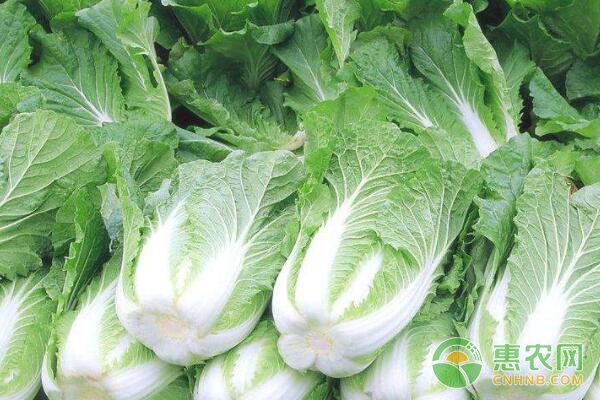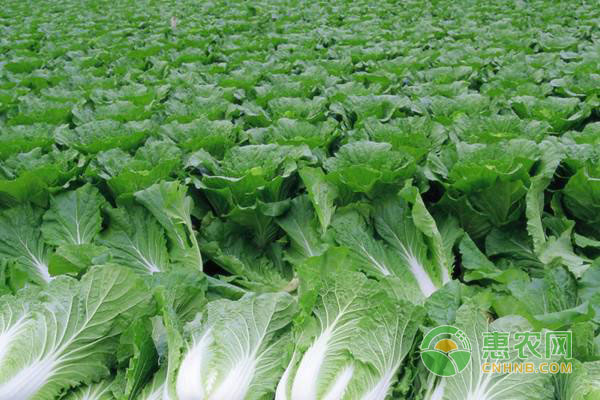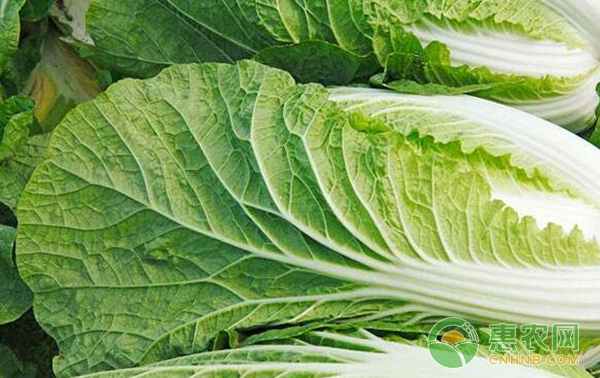How can I grow high quality Chinese cabbage? High quality Chinese cabbage planting management technology
Chinese cabbage, as a common vegetable in our life, has always been a common planting species for growers, and it has also earned a lot of profits for vegetable growers. The following small series will tell you about the quality management techniques of Chinese cabbage cultivation.

Chinese cabbage has a very high nutritional value, including dietary fiber, protein, fat, water, potassium, sodium, calcium, magnesium, iron, zinc, Vitamin C, etc., as well as rich crude fiber. It is the main variety of vegetables in autumn and winter in my country. It is the main dish of the people in autumn and winter. Therefore, it is very important to take effective measures to comprehensively improve the level of planting management, control or reduce the occurrence of diseases, and increase the yield of Chinese cabbage. , summarize its high-yield cultivation techniques as follows.
First, the variety selection
In addition to considering the climate, fertilizer and water conditions, it is also necessary to choose a strong disease resistance, high yield, and strong adaptability according to local conditions. At the same time, different varieties are selected according to people's eating habits and different uses of Chinese cabbage. Such as Jin Green 75 and other early maturing small varieties. Or mid-late mature varieties with higher yield, such as Dongnong 909, Beichen No. 7, Jinlu 80, “601â€, Dongbai No. 4, Lubai No. 3, Beijing New No. 3, Fengkang 85, etc. In addition, the cabbage is not heavy, and the same plot is continuously planted with a variety that is highly susceptible to infection, and the variety can be changed according to the situation.
Second, planting time
Cabbage that is listed in advance should be sown in early August; winter storage of cabbage should be 3-5 days before and after the beginning of autumn. Late-maturing varieties with long growing period can be broadcast early, and medium-maturing varieties with short growing period can be broadcasted for several days. According to the production situation in recent years, the high temperature in the early stage is not good for the growth of seedlings, and the harvest period is unfavorable for storage. If the selected species are not long varieties in the growing season, it is best to plant them in the late days after the autumn, and combined with high ridge cultivation, the disease can be significantly alleviated.

Third, cultivation techniques
1. Seed treatment.
To prevent black spot, soak seeds in warm water at 50 °C for 25 minutes, cool and dry for sowing, or seed dressing with 0.2% to 0.3% of the weight of the seeds. Mixing 150g of seeds with Fengling 50-100g can prevent soft rot of Chinese cabbage. For downy mildew, seed dressing can be done with 25% metalaxyl wettable powder with 0.3% seed weight.
2, fertilizing watering
Fertilization: Before the sowing, the base fertilizer advocates the application of multiple decomposed organic fertilizers, and the “lifting fertilizer†can be combined with the base fertilizer. If the bottom fertilizer is insufficient, the first time can be used in 3-4 true leaves, 10 kg of urea per acre, applied to both sides of the seedlings, and immediately watered, called "lifting fertilizer"; the second time after the seedlings, Applying 15-20 kg of potassium sulphate compound fertilizer per acre, applying ditch on both sides of the ridge, called “fat fertilizerâ€, the third time in the rose seat period, applying 25-30 kg of urea per acre, superphosphate 10-15 Kilograms, the fertilizer is applied into the ditch or the hole, then the soil is poured, watered, called "large top dressing", and the policy is applied four times in the middle of the ball, 15-20 kg of ammonium sulfate per acre, which can be applied with water, called "irrigation". Heart fat." Note: In order to prevent heartburn and rot of cabbage, ammonium nitrate should be avoided as much as possible. In addition, since Chinese cabbage is a calcium-producing crop, spray 2-3 times of 0.2% calcium nitrate or calcium chloride solution during the rosette period to the beginning of the ball. It can prevent "dry heart".
3. Seedling management
At this time, it should be time and seedlings. In the case of Lacrosse and 3-4 true leaves, each seedling was used once, and weeds, diseased plants and weak seedlings were removed. 5 pieces of true leaves, seedlings, seedlings 10 cm, in high temperature and dry years, appropriate late seedlings, so that seedlings dense, cover the ground, reduce ground temperature, reduce the occurrence of disease. And timely cultivating, cultivating should not be deep, because the roots of cabbage are shallow, so as not to damage the roots and leaves. The grass should be removed by hand as much as possible to avoid the number of times of smashing, causing root damage and causing the disease to spread from the roots. When the seedlings encounter heavy rain, they should be drained and flooded in time.
Watering: Chinese cabbage from the group to the rosette period, the temperature is decreasing, the weather is mild, water can be properly watered here, keep the soil dry and wet, the water can be properly controlled for several days at the end of the rosette, and then watered after the third top dressing After the cabbage enters the ball-forming period, it needs the most water. Therefore, the seedlings should be poured once after the end of the seedlings; then the second water is poured after 2-3 days. If the soil is cracked, the lateral roots will be broken. The fine roots die, affecting the ball; afterwards, the water is usually poured once every 5-6 days to keep the soil moist.

Four, bundled leaves
In the late growth period of Chinese cabbage, the weather is changeable and the temperature is decreasing. To prevent frost, it should be bundled in time. Generally, 10-16 days before harvest, stop watering, lift the rosette leaves, hold the leaf ball, and then use sweet potato glutinous rice or The grain grass binds the leaves, making the core tighter and continue to grow.
V. Prevention and control of pests and diseases at maturity
1. There are three major diseases in Chinese cabbage: downy mildew, viral disease, soft rot, black spot.
(1) Downy mildew: also known as "branches", "white mold" and so on. It mainly occurs during the rosette period to the core period. Use 75% chlorothalonil 500-600 times solution, or 40% ethyl phosphorus aluminum 150-200 times solution, etc., continuously control 2-3 times.
(2) Viral disease: also known as lone disease, madness. Mainly in the seedling stage, high temperature and drought are easy to develop. Control method: reduce soil temperature and timely control aphids. Spraying 2-3 times with Phytophthora 1000 times solution or virion 600 times solution and anti-Polycarb 2000 times solution or mites net 2000 times solution.
(3) Soft rot: a bacterial disease. At the time of onset, the agricultural streptomycin 150-200 times solution, or the neo-phytomycin 4000 times solution spray, or 70% dikesone powder 500-1000 times solution to water the diseased plants and the surrounding healthy plant roots.
(4) Black spot disease: use disease-resistant varieties, seed disinfection, eliminate diseased plant residues, weeds, apply sufficient base fertilizer, increase phosphorus and potassium fertilizer, and improve disease resistance of vegetable plants. The diseased plants were found to be sprayed with 75% chlorothalonil or 58% metalaxyl manganese or 10% difenoconazole 900-1300 times or 43% tebuconazole suspension 2000~2500 times.
2. The main pests of Chinese cabbage are aphids, cabbage caterpillars, and diamondback moths.
(1) Aphids: 10% nicotine (Kanghelin) 800~1000 times liquid, 25% Aketai 750~1500 times liquid, 3% acetamiprid (Mobilang) 2000~3000 times liquid prevention.
(2) Pieris rapae, yellow stripe and underground pests. Control with deltamethrin (enemy kill) 2000 times solution, 15% cypermethrin 1000 times solution. (3) Plutella xylostella: using 5% Regent suspension agent 50-100 ml per mu to 60 kg of water control; 5% inhibition of Taibao EC 2000 times solution or 3% Kwei salt microemulsion 4000~6000 times solution or 2% Biological pesticides such as avermectin 3000~5000 times liquid. In addition, biological control technology-sex attractant can be used to trap adult insects. In the early stage of Plutella xylostella, the low density of insects in the field can also play a good control effect.
Sixth, timely harvest
Harvest as much as possible, not too early. In combination with the weather conditions, the harvest should be delayed as much as possible under the premise of preventing frost damage, and dried for 2-3 days after harvest to reduce the water content of the outer leaves to facilitate cold storage.
The above is the management technology of high quality Chinese cabbage cultivation organized by Huinong.com, have you learned it? If you want to know more about agricultural technology, please pay attention to the Hui Nong School!
Health foods contain a certain amount of functional health ingredients, which can regulate the functions of the human body, have specific effects, and are suitable for specific groups of people. General food does not have specific functions, and there is no specific range of people to eat. Health food cannot be directly used to treat diseases. It is a human body mechanism regulator and nutritional supplement.
DHA, NMN, MCT, CLA, Melatonin, Creatine
Xi'an Gawen Biotechnology Co., Ltd , https://www.ahualyn-bios.com